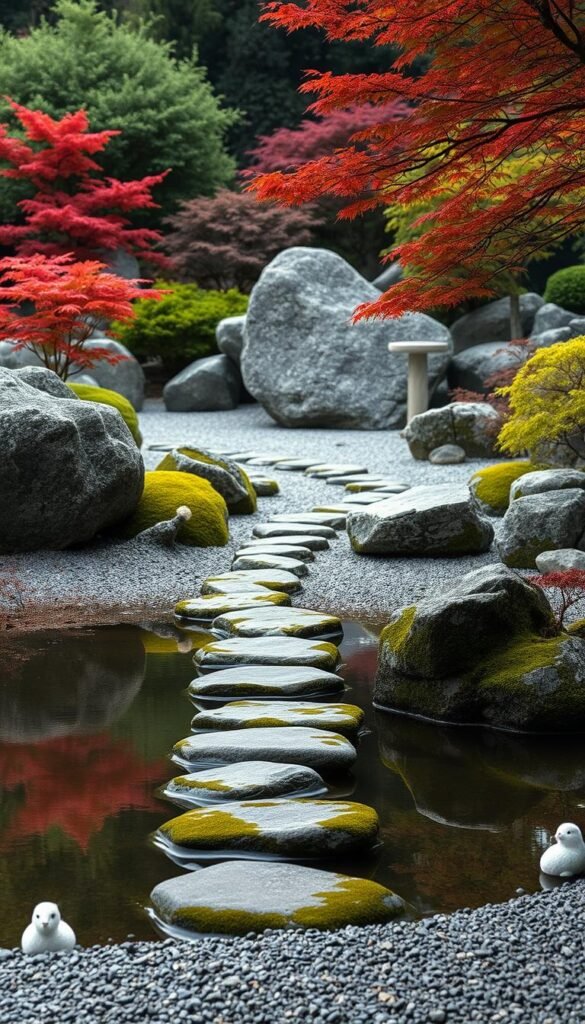Imagine stepping into an outdoor space where every element feels intentionally placed, yet effortlessly natural. For centuries, these carefully crafted landscapes have served as places of meditation, blending symbolic representations of nature with human creativity. Rooted in Zen philosophy, their unspoken language of balance speaks directly to our modern need for calm.
You’ll notice how simple arrangements of stones and flowing water create visual poetry. Dry gravel patterns mirror ocean waves, while moss-covered boulders suggest ancient mountains. This approach transforms ordinary yards into living art that evolves with the seasons.
What makes these spaces so captivating? They follow core principles of tranquility that anyone can apply. Through strategic placement and minimalist choices, you can craft areas that invite reflection without overwhelming the senses. Even small urban patios gain depth when designed with this mindful approach.
We’ll explore how to select materials that age gracefully and arrange them to tell visual stories. Discover why centuries-old techniques remain relevant for contemporary homes seeking respite from today’s fast-paced world. Your journey to creating a personal retreat starts here.
Introduction to the Japanese Garden Aesthetic
Crafting a peaceful retreat begins with understanding how every stone and ripple tells a story. These spaces don’t just look pretty—they guide your gaze and slow your breathing. At their core, they mirror nature’s rhythms through curated arrangements that feel both wild and deliberate.
Where Silence Meets Intention
You’ll find tranquility in spaces designed to whisper rather than shout. Moss creeps over weathered stones, while raked gravel mimics water’s flow. This isn’t about filling empty areas but creating room for thought. Negative space acts like punctuation, letting each element breathe.
Principles Shaped by Centuries
Three core ideas shape these landscapes:
- Balance through asymmetry (no mirrored layouts)
- Symbolism over literal representation
- Seasonal awareness in plant choices
Unlike Western styles that prioritize blooms, here structure reigns supreme. Bamboo fences frame views, while strategic plant placement elevates your space without clutter. It’s about editing, not adding.
| Element | Traditional Role | Modern Adaptation |
|---|---|---|
| Rocks | Represent mountains/islands | Focal points in minimalist beds |
| Water | Symbolizes purity/life flow | Recirculating fountains for small yards |
| Gravel | Depicts oceans/rivers | Low-maintenance ground cover |
| Plants | Seasonal markers | Native species for sustainability |
Notice how materials age gracefully? Weathering isn’t just allowed—it’s celebrated. This approach turns your outdoor area into a living journal where time becomes part of the design.
Understanding the Origins and Philosophy of Zen Gardens
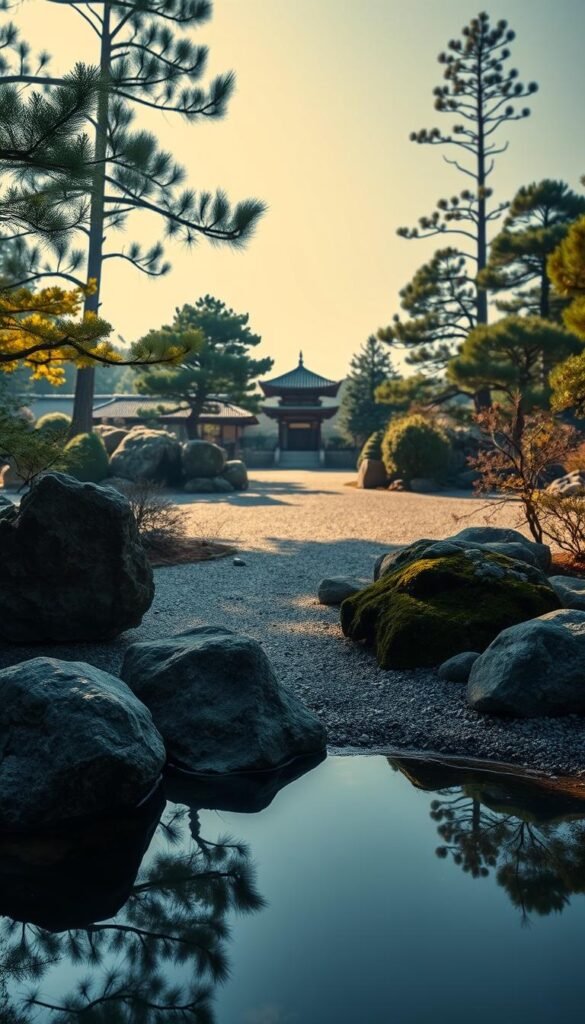
Have you ever wondered how raked gravel became a path to inner peace? These landscapes began as monastic tools, shaped by spiritual seekers who saw nature as a mirror for the soul. Their designs don’t just please the eye—they invite you to see the world differently.
Where Spirit Meets Soil
Zen Buddhist monks crafted the first dry landscapes as places for active meditation. By arranging stones and raking patterns, they practiced mindfulness through movement. This approach reflects core principles of simplicity and presence—cornerstones of their philosophy.
“A crack in a stone isn’t a flaw—it’s proof of life’s enduring story.”
Wabi-sabi aesthetics deepened this connection. Instead of chasing perfection, gardeners celebrated weathering and decay. Moss on rocks? A reminder of time’s passage. Uneven gravel lines? A nod to life’s unpredictable flow.
From Monasteries to Modernity
Early zen gardens emerged during Japan’s Heian period (794-1185), evolving into symbolic art forms by the Muromachi era. Key practices survive today:
- Morning raking as moving meditation
- Strategic stone placement to represent islands or mountains
- Using native plants that shift with seasons
| Era | Design Focus | Key Practice |
|---|---|---|
| Heian Period | Spiritual symbolism | Stone groupings as deities |
| Muromachi | Dry landscapes | Gravel as water metaphors |
| Modern | Urban adaptation | Miniature desktop gardens |
These spaces still teach us to embrace change. A storm alters the gravel’s curves. Leaves blanket moss. Yet each shift mirrors life’s constant dance—a lesson in letting go.
Embracing Minimalist Design in Your Outdoor Space
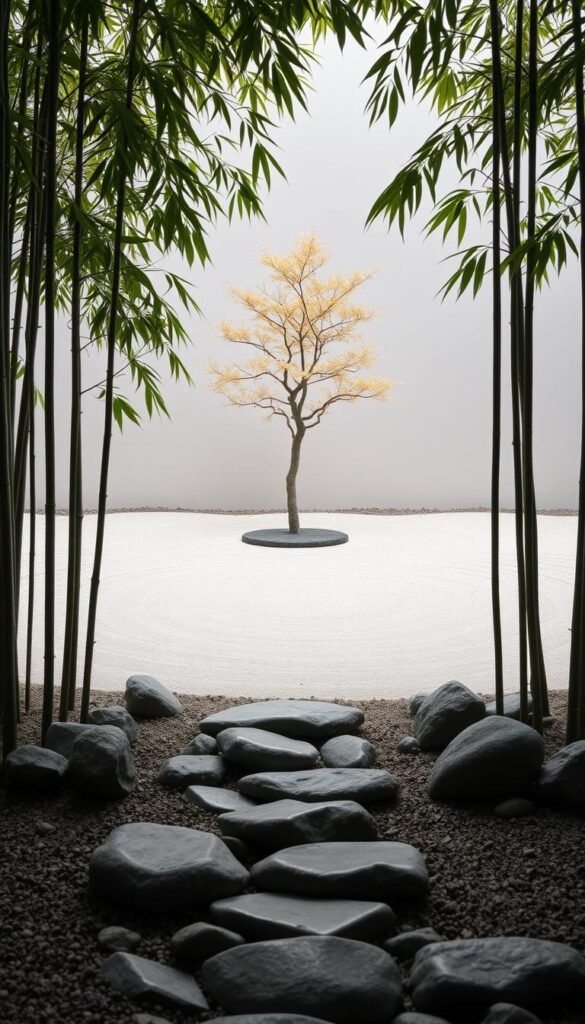
What if less clutter could make your backyard feel larger? The answer lies in curated simplicity, where every item earns its place through purpose or beauty. This approach transforms crowded patios into peaceful retreats that breathe.
Streamlining Elements for Clarity
Start by asking: “Does this object serve a function or spark joy?” If not, it might dilute your zen garden experience. Apply the Kanso principle by removing visual noise—extra ornaments, mismatched pots, or plants that compete for attention.
Focus on three key elements:
- Repeating 2-3 plant species creates rhythm
- Grouping stones in odd numbers feels natural
- Leaving open space between features
Small areas benefit most from this strategy. A single maple tree surrounded by moss says more than a dozen shrubs. Let textures do the talking—smooth pebbles beside rough boulders, raked gravel mimicking water.
“Simplicity isn’t about emptiness—it’s about making room for what matters.”
Editing an existing garden? Remove one-third of decorations first. Notice how the remaining pieces gain impact. This restraint allows your design to whisper serenity rather than shout for attention.
Establishing Balance with Nature in Your Garden
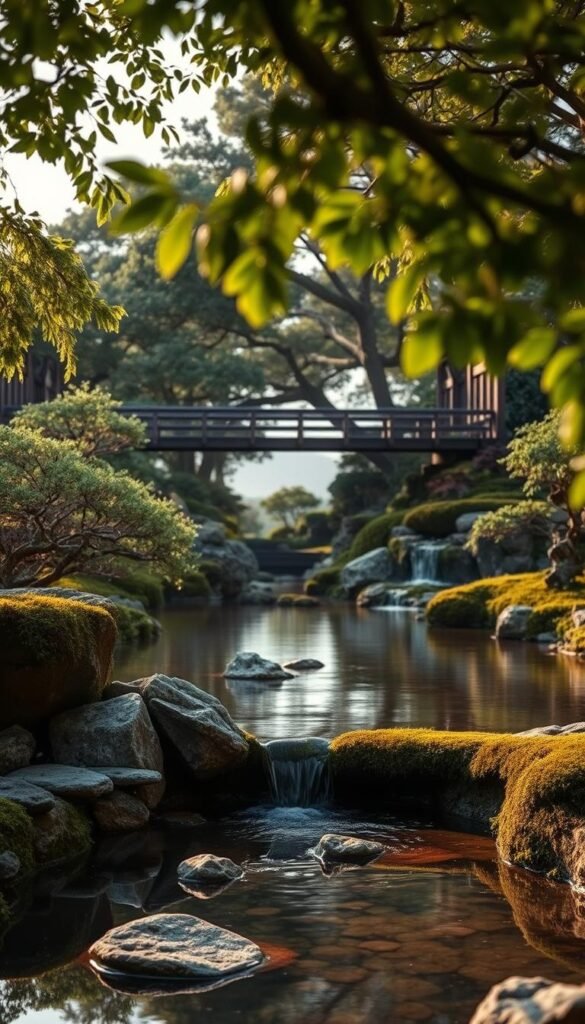
How do designers create spaces that feel untouched by human hands? The answer lies in Shizen—the art of crafting landscapes that appear spontaneous while hiding meticulous planning. This principle teaches you to arrange stones, plants, and water so they look like they’ve always belonged there.
Design That Breathes
Start by observing your yard’s existing features. A sloping terrain becomes a cascading gravel stream. Native ferns clustered near a boulder mimic how they grow in wild forests. Your goal? Make every addition feel inevitable, not imposed.
Try these techniques for seamless integration:
- Match stone colors to local geology
- Let moss grow between pavers naturally
- Use irregular plant spacing
“A garden should whisper secrets only the wind knows.”
Modern elements like corten steel planters work when paired with organic shapes. Their rusted surfaces echo autumn leaves, creating visual harmony without competing with nature. Even small touches matter—a curved path feels more inviting than straight lines.
Remember, balance isn’t about symmetry. It’s about respecting your land’s personality. If your soil stays damp, embrace moisture-loving plants instead of fighting drainage issues. This approach deepens your connection to the natural world while reducing maintenance.
Enhancing Serenity Through Water Features
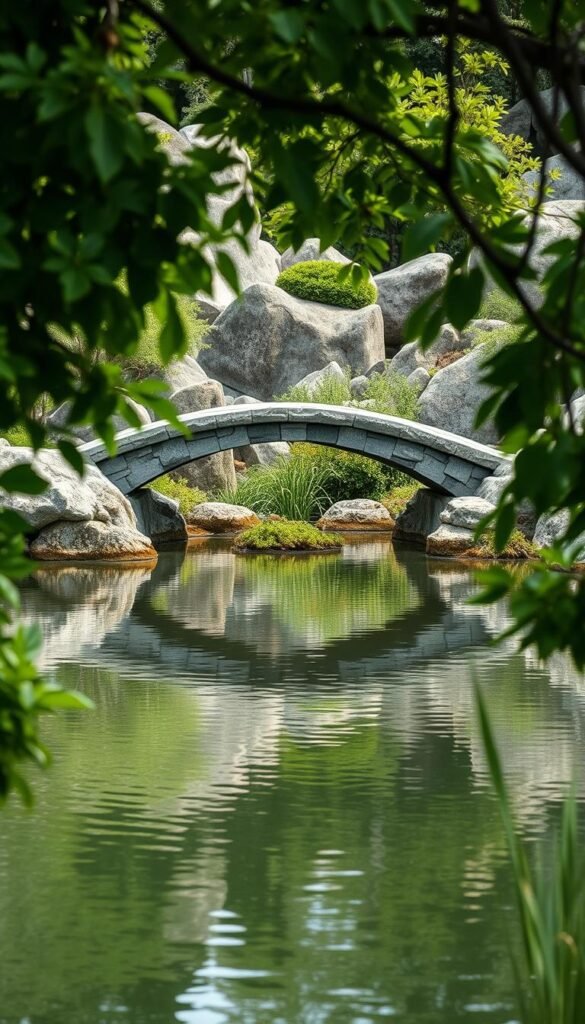
What if stillness could speak? In contemplative spaces, water elements become storytellers. Whether flowing or implied, they shape moods and guide reflection. Your choice between actual water and symbolic representations will define your space’s rhythm and upkeep needs.
Fluid Choices for Modern Spaces
True water features—like stone basins or cascading streams—offer sensory richness. The sound of trickling water masks urban noise, while reflections double your garden’s visual depth. But they require pumps, cleaning, and winterization.
Dry landscapes (karesansui) use gravel and stones to suggest rivers or oceans. Raking patterns becomes a moving meditation, adapting with your creativity. This approach suits small yards or busy schedules, needing only occasional upkeep.
| Feature | Maintenance | Best For | Symbolism |
|---|---|---|---|
| Ponds/Streams | Weekly cleaning | Spacious areas | Life’s continuity |
| Stone Basins | Seasonal draining | Entryways | Purification rituals |
| Raked Gravel | Biweekly refreshing | Urban patios | Time’s passage |
| Waterfalls | Pump maintenance | Sloped terrain | Nature’s power |
Consider your local climate. Freezing temperatures? Dry elements avoid ice damage. Humid regions? A bamboo fountain thrives. Blend both styles: add a small basin beside raked gravel to honor water’s dual roles—physical and imagined.
Remember, every ripple or stone curve should feel purposeful. As one designer notes: “Water isn’t decoration—it’s an invitation to pause.” Whether you choose liquid serenity or its poetic suggestion, let it deepen your connection to the moment.
The Symbolism Behind Stones and Gravel
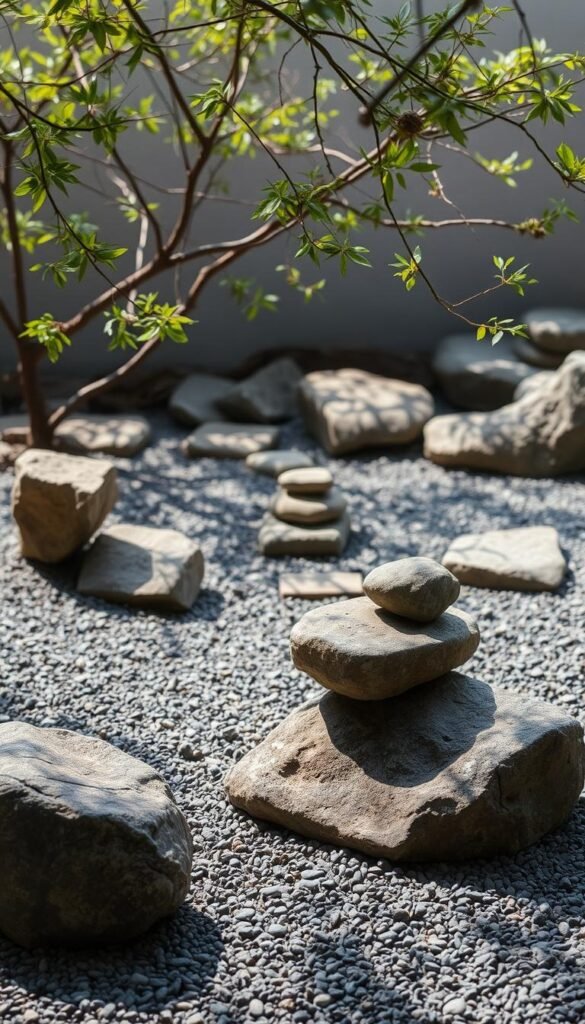
Every stone in a zen garden whispers a story through its shape and position. Unlike manicured lawns, these spaces celebrate raw, unaltered elements that mirror nature’s imperfections. Let’s decode their silent language.
Understanding the Significance of Each Rock
Vertical stones reach skyward like ancient trees, while horizontal ones anchor the design like sleeping giants. Their placement follows the Rule of Threes—groupings of odd numbers that feel organic. This technique avoids rigid symmetry, letting your eye wander naturally.
Three key traits define meaningful rock selection:
- Surface texture (moss-friendly vs. smooth)
- Natural weathering patterns
- Proportions relative to other elements
“Stones are the bones of the earth—their cracks hold centuries of rain and sun.”
| Stone Type | Symbolic Meaning | Ideal Placement |
|---|---|---|
| Tall Vertical | Mountain peaks | Backdrop areas |
| Flat & Wide | Earth’s stability | Path edges |
| Angular | Dynamic energy | Focal points |
| Rounded | Softened by time | Water features |
Gravel serves as the yin to stones’ yang. Raked into wave-like patterns, it becomes a meditation tool. The act of smoothing and reshaping teaches focus—each swipe clearing mental clutter as much as physical debris.
Notice how light plays on rough rocks versus fine gravel? This contrast mirrors life’s balance between solid truths and fleeting moments. Your garden becomes a map of mindfulness, where every element invites deeper looking.
Mastering Japanese Rock Garden Design Techniques
Transforming ordinary spaces into serene landscapes begins with mastering the dialogue between stone and space. These design techniques turn backyard corners into meditation zones where every pebble holds meaning. Let’s explore how intentional arrangements create visual havens.
Stone Groupings That Tell Stories
Place rocks like nature dropped them there. Use odd-number clusters (3, 5, 7) to mimic how trees grow wild. Tall vertical stones become distant peaks, while flat ones anchor the scene like riverbanks. Always bury 1/3 of each stone—it makes them look settled, not placed.
| Group Size | Symbolic Meaning | Placement Tip |
|---|---|---|
| 3 stones | Mountain ranges | Place tallest at back |
| 5 stones | Island chains | Vary heights dramatically |
| Single stone | Solitary peak | Offset from center |
Raking as Active Meditation
Your gravel becomes liquid under the rake. Parallel lines suggest calm ponds, while swirling raked patterns echo stormy seas. This practice isn’t about perfection—it’s about presence. Many find the rhythmic motion quiets mental chatter better than seated meditation.
Try these patterns:
- Concentric circles around stones (water ripples)
- Wavy lines across wide areas (flowing streams)
- Spiral designs near seating areas (energy focus)
“The rake is your paintbrush—the gravel your canvas.”
Remember, your rock garden evolves with use. Adjust stone angles as sunlight shifts seasons. Refresh raked patterns after rain—each session deepens your zen connection to the space.
Japanese Garden Aesthetic: Achieving Harmony with Rocks, Water
Creating a sanctuary in your backyard starts with embracing nature’s silent dialogue. Japanese Rock Gardens show how intentional design fosters connection—not just between elements, but with your inner self. These spaces become mirrors reflecting balance, where weathered stones and flowing streams write poetry without words.
You’ll discover how rock arrangements and water features converse through contrast. Jagged boulders stand firm against raked gravel’s fluid lines, embodying harmony through opposition. This interplay teaches a valuable lesson: stillness and movement can coexist beautifully.
What makes zen gardens timeless? They honor simplicity as a pathway to clarity. Each stone placement invites you to pause, while every ripple in a basin whispers of life’s ephemeral flow. Your space becomes more than decoration—it’s a living meditation.
Apply these principles anywhere. A balcony corner with three stones and a shallow bowl of water holds as much power as sprawling landscapes. Remember, true harmony arises when elements feel inevitable, not forced. Your journey ends where it began: with nature’s quiet wisdom guiding every choice.

